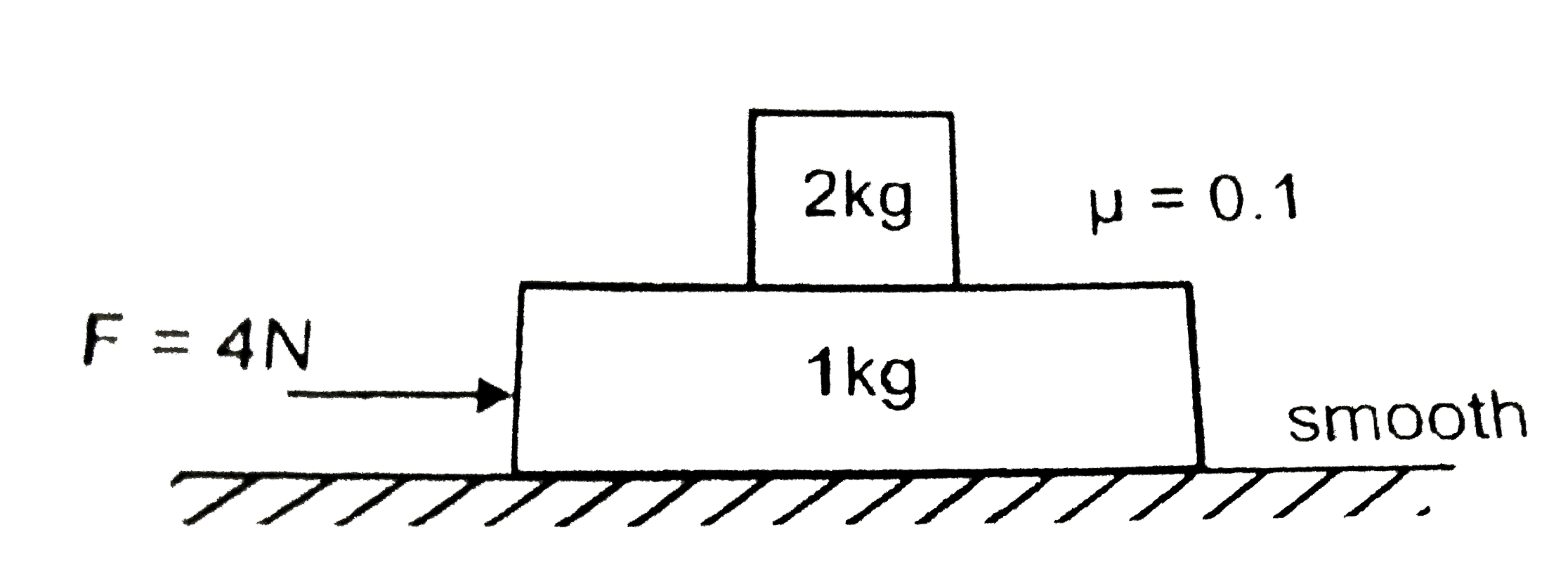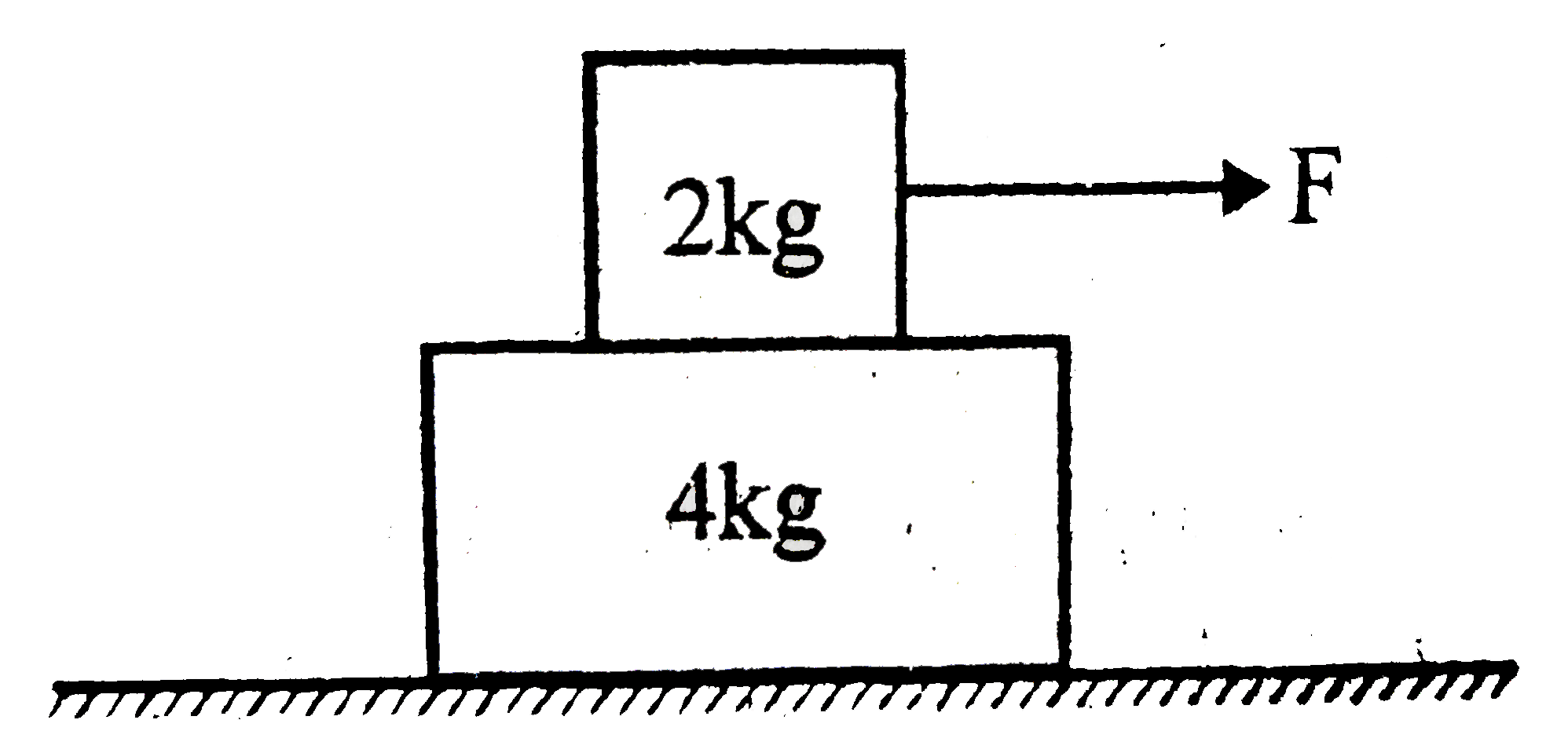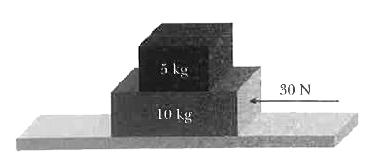The surface below 2 kg is smooth but there is friction between the blocks. Initially the blocks are static if 6N force is applied on both the blocks, then the direction of friction on

2kg block is left
3kg block is right
Kinetic friction is surely acting
Data insufficient (μ not given)
The correct Answer is:A, C
If a1 and a2 be the acceleration of blocks on incline then,
a1=gsinθ−μ1gcosθ
a2=gsinθ−μ2gcosθ
t=√2d(μ2−μ1)gcosθ
If the collision is to occur on incline, this 't' must be less than the time that block I would take to slide down the entire incline if given a chance to move alone. As that is the case, velocity v1 and v2 of bodies just before collision
v1=a1t
v2=a2t
If v be the common velocity just after collision
v=m1v1+m2v2m1+m2
Loss of kinetic energy = 12m1v21+12m2v22−12(m1+m2)v2
Putting the value and solving we get
Loss in K.E. = 0.16 Joules.

Related Playlists
Similar Questions
The friction coefficient between the blocks is μ. If force F is applied on the lower block , analyse motion of two blocks.
 View Solution
View SolutionA slab of 40kg lying on a frictionales floor and a block of 10 kg rests on the slab as shown in the figure. The coefficients of static and kinetic friction between the slab and the block are 0.6 and 0.4 respectively. If a force of 100N is applied on the block, then the acceleration the slab will be (g=10m/s2)
 View Solution
View SolutionOn a smooth horizontal surface a block A of mass 10kg is kept. On this block a second block B of mass 5kg is kept. The coefficient of friction between the two blocks is 0.4 .A horizontal force of 30N is applied on the lower block as shown. The force of friction between the blocks is
View Solution2gk block is kept on 1kg block as shown . The friction between 1kg block and fixed surface is absent and the coefficient of friction between 2kg block is μ=0.1. A constant horizontal force F=4N is applied on 1kg block. If the work done by the friction on 1kg block in 2s is −XJ, then find X. Take g=10m/s2.
 View Solution
View SolutionA small block of mass 20kg rests on a bigger block of mass 30kg, which lies on a smooth horizontal plane. Initially the whole system is at rest. The coefficient of friction between the blocks is 0.5. The horizontal force F=50N is applied on the lower block.

a. Find the work done by fricitonal force on upper block and on the lower block in t=2s.
b. Is the magnitude of work done by the frictional force on upper and lower blocks same?
c. Is the work done by the frictional force on the upper block converted to heat or mechanical energy or both?View SolutionBlock A of mass 3 kg is placed on another block B of mass 5 kg placed on the smooth surface. If coefficient of friction between two blocks is 12 and 32 N force is applied on block B as shown in the figure, then the work done by the frictional force on block A in first two second will be (initial velocity of the system is zero and g=10ms2)
 View Solution
View SolutionConsider the shown arrangement. The coefficient of friction between the two blocks is 0.5 . There is no friction between the 4 kg block and of 12 N is applied on the 2 kg block as shown in the figure, the acceleration of the 4 kg block would be
 View Solution
View SolutionTwo blocks rest on a horizontal frictionless surface as shown in the figure. The surface between the top and bottom blocks is roughened so that there is no slipping between the two blocks. A 30-N force is applied to the bottom block as suggested in the figure.

What is the magnitude of the force of static friction between the top and bottom blocks?View Solution
When F = 2n, the frictional force between 10 kg block 5 kg block isView SolutionBlock A weight 20kg placed on a smooth surface. Weight B of 2kg is mounted on the block . The coefficient of friction between the block and the weight is 0.25 Calculate the acceleration of the block and the weightand also the frictional force between the block and the weight when a horizontal force 2N applied to the weight as shown in fig What will these quantities be if the horizontal force is 20N?(g=10ms−2)
 View Solution
View Solution


